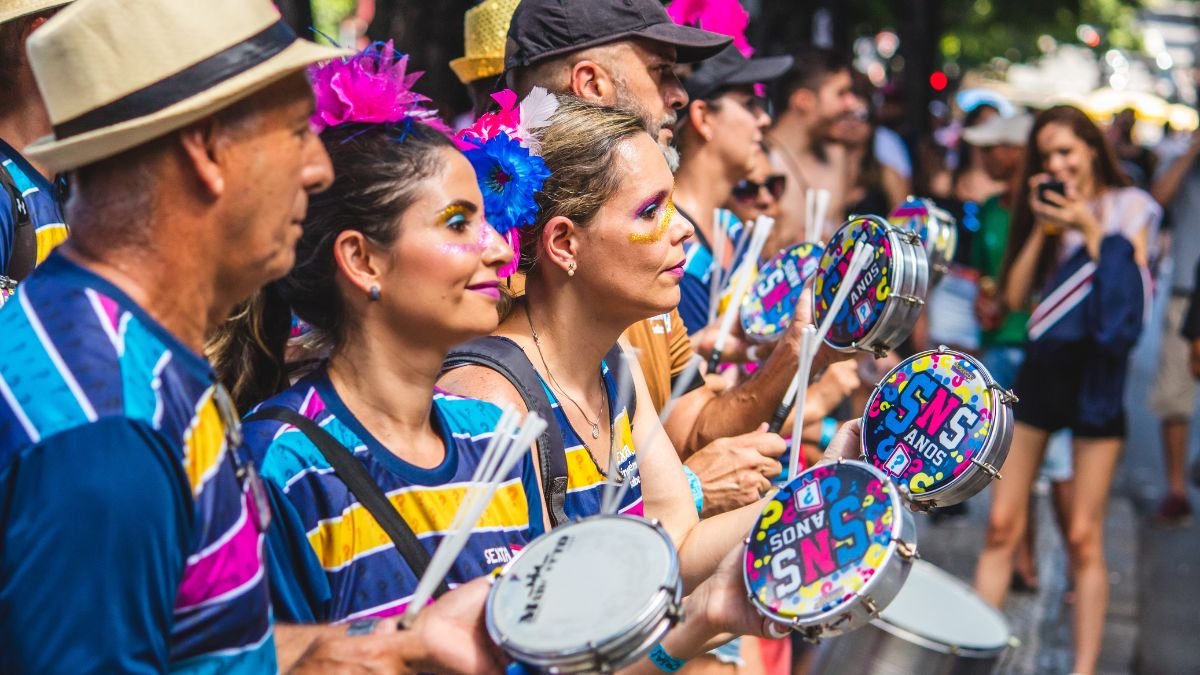Introduction
Have you ever wondered why the Southeast Region of Brazil stands out as a cultural epicenter? This vibrant area is home to over 55% of the country’s population, blending indigenous, African, and Portuguese influences into a unique tapestry that reflects the rich history and diversity of its people, showcasing the true Culture of Brazil.
The region is renowned for its dynamic music scene, particularly the rhythmic beats of samba, which originated in the Afro-Brazilian communities and has become a symbol of national identity. Additionally, the Southeast boasts a culinary landscape that is as diverse as its population, offering an array of flavors from traditional dishes like feijoada to contemporary fusion cuisine that highlights local ingredients.
From the rhythmic beats of samba to the rich flavors of its cuisine, this region offers experiences that captivate the senses, inviting visitors to immerse themselves in its vibrant culture and traditions.

The Southeast is not just a hub for traditions; it’s also a UNESCO-recognized treasure trove. With its diverse and creative sites and intangible heritage elements, it showcases the richness of its people. Whether it’s the lively festivals or the historic landmarks, every corner tells a story.
As South America’s largest country, Brazil’s Southeast Region is a microcosm of its global appeal. Its music, history, and cuisine have left an indelible mark on the world. Ready to explore what makes this area so inspiring? Let’s dive in.
Key Takeaways
- The Southeast Region is Brazil’s cultural heart, blending indigenous, African, and Portuguese influences.
- It houses 55% of the country’s population, making it a vibrant and diverse area.
- UNESCO-listed sites and intangible heritage elements highlight its global significance.
- Known for samba, festivals, and historic landmarks, it’s a must-visit for cultural enthusiasts.
- Its cuisine and music have gained worldwide recognition, reflecting its rich traditions.
Vibrant Culture of Brazil
Brazil’s cultural identity is a vibrant blend of traditions from across the globe. The Portuguese language dominates, but it’s enriched by Tupí-Guaraní linguistic influences. This unique mix reflects the country’s history of colonization and indigenous heritage.
African cultural strongholds are prominent along the Northeast-Rio coastline. These areas showcase rhythms, dances, and traditions that have shaped the nation’s identity. Meanwhile, indigenous contributions remain vital, with 700,000 indigenous people preserving 180 languages despite a lack of official recognition.
Brazil’s concept of “racial democracy” highlights its diverse population. Demographics include 55% European, 22% mixed-race, and 12% caboclo ancestry. This blend creates a unique social fabric that continues to evolve.
However, cultural preservation faces challenges from global commercial influences. São Paulo, the cultural capital, stands as a beacon of resilience. Its Sala São Paulo concert hall is a testament to the state’s commitment to the arts.
Religious syncretism is another fascinating aspect. Approximately 13% of the population practices Afro-Brazilian religions in conjunction with Catholicism. This blend of faiths reflects the country’s ability to harmonize diverse traditions.
Regional diversity is equally striking. From Amazonian indigenous traditions to Southern European immigrant communities, each area adds to the rich tapestry of Brazil’s identity. This makes it a truly unique country in the world.
The Heartbeat of Brazil: Samba and Bossa Nova
From samba to bossa nova, the Southeast pulses with musical energy. These iconic styles have shaped the region’s identity, blending African, indigenous, and European influences. Whether you’re dancing in Rio or listening to jazz in São Paulo, the rhythms tell a story of creativity and passion.
Experience the Rhythms of Rio de Janeiro
Rio de Janeiro is synonymous with samba, a dance and music style rooted in Angolan semba and Bahian circle dances. The city’s samba schools, like Mangueira and Salgueiro, are legendary for their Carnival parades. Each year, these schools compete in a dazzling display of costumes, choreography, and percussion.
For a more intimate experience, head to the Lapa neighborhood. Venues like Carioca da Gema offer live performances that capture the soul of samba. Here, the music isn’t just entertainment—it’s a way of life.
Discover the Origins of Bossa Nova in São Paulo
While Rio is the home of samba, São Paulo is where bossa nova found its voice. This smooth, jazz-inspired style emerged in the 1950s, blending João Gilberto’s guitar innovations with Vinicius de Moraes’ poetic lyrics. Tom Jobim’s “Garota de Ipanema” became a global anthem, introducing bossa nova to the world.
Today, São Paulo celebrates its musical heritage through events like jazz festivals in the Beco do Batman area. The Museum of Image and Sound (MIS) also offers exhibitions that delve into the history of these genres. Whether you’re a music enthusiast or a casual listener, the Southeast’s sounds will leave you inspired.
Culinary Delights: A Taste of Brazilian Cuisine
Exploring Brazil’s Southeastern cuisine is a journey for the senses. This region is a melting pot of flavors, blending African, indigenous, and Portuguese influences. From hearty stews to street food, every dish tells a story of history and tradition.
Feijoada: Brazil’s National Dish
Feijoada, a rich black bean stew, is a cornerstone of Brazilian cuisine. Its origins trace back to enslaved people who used pork offal to create this hearty dish. Today, it’s a symbol of family gatherings and cultural pride.
In São Paulo, Casa de Feijoada offers a modern twist on this classic. Meanwhile, Rio’s Confeitaria Colombo serves a traditional version. Both are must-try experiences for any food lover.
Street Food Adventures in Belo Horizonte
Belo Horizonte is a haven for street food enthusiasts. With over 280 bars per capita, the city’s vibrant life revolves around its culinary scene. Try pão de queijo, a cheesy bread, or tutu à mineira, a creamy bean paste.
The Central Market is a must-visit for tasting doce de leite. Here, you’ll find a variety of sweets and snacks that reflect the area’s rich heritage.
| Dish | Key Ingredients | Origin |
|---|---|---|
| Feijoada | Black beans, pork, rice | Southeast Region |
| Pão de Queijo | Cheese, tapioca flour | Minas Gerais |
| Vatapá | Dende oil, shrimp, bread | Bahia |
Brazilian traditions also shine during the new year. Lentil stew is a staple, symbolizing prosperity and good fortune. Whether you’re savoring feijoada or exploring street food, the Southeast’s culinary scene is unforgettable.
Architectural Marvels: From Colonial to Modern
From colonial churches to futuristic designs, the Southeast showcases Brazil’s architectural evolution. The region’s history is reflected in its structures, blending indigenous, African, and European influences. Each building tells a story of creativity and cultural fusion.

Over time, these structures have become landmarks, attracting visitors from around the world. Whether it’s the baroque style of Minas Gerais or the modernist designs of Brasília, the Southeast is a treasure trove of architectural wonders.
Oscar Niemeyer’s Iconic Designs in Brasília
Oscar Niemeyer, a pioneer of modernist architecture, left an indelible mark on the Southeastern United States. His 500+ buildings include the Niterói Contemporary Art Museum, a futuristic structure perched on a cliff. In Brasília, his designs, like the Three Powers Plaza, redefine urban landscapes.
The Pampulha Modern Ensemble, a UNESCO World Heritage site, is another testament to his genius. By the 20th century, Niemeyer’s work had gained global recognition, influencing architects worldwide.
Historic Churches in Minas Gerais
The state of Minas Gerais is home to some of Brazil’s most iconic churches. Dating back to the 18th century, these structures showcase the baroque style. Aleijadinho’s soapstone carvings in Ouro Preto’s São Francisco Church are a masterpiece of craftsmanship.
Tiradentes’ Santuário da Boa Morte is another gem, with its intricate details and historical significance. These churches are not just places of worship but also cultural landmarks that highlight the region’s rich heritage.
| Architectural Site | Key Feature | Location |
|---|---|---|
| Niterói Contemporary Art Museum | Futuristic design by Niemeyer | Rio de Janeiro |
| São Francisco Church | Aleijadinho’s soapstone carvings | Ouro Preto |
| Pampulha Modern Ensemble | UNESCO World Heritage site | Belo Horizonte |
These regions showcase a diverse array of architectural styles, ranging from colonial to modern. Whether you’re exploring Brasília’s modernist landmarks or Minas Gerais’ historic churches, the Southeast offers a journey through time and design.
Festivals and Celebrations: The Spirit of Brazil
The Southeast Region comes alive with vibrant festivals that unite people in celebration. These events are more than just gatherings; they are a reflection of the country’s rich heritage and creativity. From grand parades to intimate rituals, every moment tells a story.
Carnival in Rio de Janeiro
Rio Carnival is one of the world’s most iconic festivals. Before the pandemic, it attracted over 2 million attendees daily. The Sambódromo parade is the heart of the event, where samba schools compete in a dazzling display of costumes, music, and dance.
Each school is judged on themes, choreography, and percussion. The scoring system ensures that every detail is taken into account. For a more immersive experience, visit the Lapa neighborhood, where live performances capture the soul of samba.
Festas Juninas in the Southeast
Festas Juninas honor Saint John with corn-based foods and lively traditions. This family-oriented celebration features the Quadrilha folk dance, where participants dress in colorful costumes and perform choreographed routines.
In Campinas, these festivals are a highlight of the year. They showcase the region’s agricultural roots and bring communities together. From corn cakes to sweet treats, the food is as memorable as the dances.
| Festival | Key Features | Location |
|---|---|---|
| Rio Carnival | Sambódromo parade, samba schools | Rio de Janeiro |
| Festas Juninas | Quadrilha dance, corn-based foods | Campinas |
| New Year’s Reveillon | White attire, fireworks | Copacabana |
Other notable celebrations include the Bumba Meu Boi festival in São Luís and the Lavagem do Bonfim ritual in Salvador. Each event adds to the Southeast’s vibrant culture, making it a must-visit for anyone seeking unforgettable experiences.
Natural Wonders: Exploring Brazil’s Landscapes
From lush mountains to pristine beaches, the Southeastern United States offers breathtaking landscapes. This region is a haven for nature enthusiasts, showcasing the diverse geography of South America. Whether you’re drawn to coastal beauty or rugged peaks, there’s something for everyone.
The Beaches of Espírito Santo
Espírito Santo’s 400km coastline is a paradise for beach lovers. The area is famous for its turtle nesting sites, where visitors can witness these majestic creatures in their natural habitat. Guarapari’s radioactive monazite sands are another notable feature, believed to possess therapeutic properties.
For a unique experience, explore the Rio Doce Valley wine routes near Marilândia. This lesser-known gem offers scenic vineyards and a taste of local life. The combination of natural beauty and cultural richness makes Espírito Santo a must-visit destination.
The Serra da Mantiqueira Mountains
The Serra da Mantiqueira range is a haven for adventure seekers. At 2,798 meters, Pico das Agulhas Negras is the highest peak, offering stunning views and challenging hikes. The state of Minas Gerais is home to Campos do Jordão, known for its Swiss-style architecture and cool mountain air.
Caparaó National Park is another highlight, home to the endangered muriqui monkeys and a diverse array of flora. For history buffs, the Petrópolis-São Paulo railway showcases impressive engineering feats from a bygone time. These mountains are a testament to the region’s natural wonders.
For more breathtaking landscapes, explore Serra Dos Órgãos and Chapada dos Veadeiros, two of Brazil’s most iconic national parks. These destinations highlight the incredible diversity of the country’s natural beauty.
Art and Literature: The Creative Soul of Brazil
The creative spirit of Brazil’s Southeast is deeply rooted in its art and literature. This region has produced some of the most influential artists and writers in South American history. Their works reflect the diversity and richness of the people and their experiences.
The Works of Cândido Portinari
Cândido Portinari is one of Brazil’s most celebrated artists. His murals, such as “War and Peace” at the UN Headquarters, showcase his unique style and commitment to social themes. Portinari’s work often depicted the struggles and triumphs of everyday people, making him a voice for the marginalized.
His influence extends beyond Brazil, earning him recognition on the global stage. Portinari’s ability to blend traditional techniques with modern themes has left a lasting impact on the art world.
Brazilian Literature: From Machado de Assis to Modern Authors
Machado de Assis, a 19th-century writer, is considered a pioneer of psychological realism. His novels, such as “Dom Casmurro,” explore complex human emotions and societal norms. Assis’s work remains relevant, offering insights into the history and culture of his time.
In the 20th century, Guimarães Rosa’s “Grande Sertão: Veredas” redefined Brazilian literature. This masterpiece seamlessly blends regional dialects with universal themes, crafting a narrative that resonates across diverse regions and groups.
Modern authors, such as Clarice Lispector, continue this legacy. Her existentialist novels challenge readers to think deeply about identity and the nature of existence. Together, these writers form the backbone of Brazil’s literary heritage.
- São Paulo’s Pinacoteca houses an impressive collection of Tarsila do Amaral’s works, highlighting her role in the modernist movement.
- Jorge Amado’s Pelourinho house museum in Salvador celebrates his contributions to Brazilian literature.
- The Flip festival in Paraty brings together authors and readers, fostering a love for storytelling.
- Beatriz Milhazes’ tropical abstraction is a highlight of Rio’s contemporary art scene.
Religious Diversity: A Blend of Faiths
The Southeast Region is a melting pot of faiths, reflecting centuries of history and immigration. This area is home to a unique blend of religions, from Afro-Brazilian rituals to Catholic cathedrals. Each tradition tells a story of resilience and unity.

Candomblé and Umbanda in Salvador
Salvador, the heart of Afro-Brazilian culture, is home to over 1,650 Candomblé terreiros. These houses of worship are sacred spaces where people honor African deities. The Nosso Senhor do Bonfim ritual, with its colorful ribbons, is a symbol of hope and faith.
Umbanda, another prominent religion, blends African traditions with Kardecist spiritism. It emphasizes healing and community, making it a vital part of Salvador’s spiritual landscape. The diversity of these practices highlights the region’s rich heritage.
Catholic Traditions in São Paulo
São Paulo’s Catholic traditions are deeply rooted in its history. The São Paulo Cathedral, with its neo-Gothic architecture, is a masterpiece of faith and artistry. Inside, the São Francisco Church dazzles with its 100kg gold leaf interior.
The Aparecida Basilica, visited by 12 million pilgrims annually, is a testament to the country’s devotion. Meanwhile, the Liberdade district showcases Japanese-Brazilian Buddhism, adding another layer to the city’s spiritual diversity.
| Religious Site | Key Feature | Location |
|---|---|---|
| São Paulo Cathedral | Neo-Gothic architecture | São Paulo |
| Nosso Senhor do Bonfim | Colored ribbons ritual | Salvador |
| Aparecida Basilica | 12 million annual pilgrims | Aparecida |
Conclusion: Embracing the Culture of Brazil
The Southeast Region blends history and innovation, creating a dynamic cultural experience. From colonial churches to Niemeyer’s futuristic designs, the area showcases a seamless continuity of creativity. Living traditions, such as capoeira roda circles, coexist with modern electronic music festivals, reflecting the region’s vibrant spirit.
Sustainable tourism initiatives in indigenous territories highlight the importance of preserving heritage. Emerging trends, such as LGBTQ+ Carnival blocos and urban street art, add fresh layers to the cultural landscape. These elements make the Southeast a must-visit for anyone seeking authentic experiences.
When exploring, remember to use basic Portuguese phrases and respect festival etiquette. These small gestures enhance your connection with the people and their traditions. The Southeast’s rich cuisine, music, and dance invite you to immerse yourself in its unique culture. Learn more Irresistible Brazilian Food.
FAQ
What are the must-experience musical styles in the Southeast region?
Samba and Bossa Nova are iconic. Samba thrives in Rio de Janeiro, while Bossa Nova has deep roots in São Paulo.
What is Brazil’s national dish, and where can I try it?
Feijoada, a hearty black bean stew with pork, is the national dish of Brazil. You can enjoy it in traditional restaurants across the country.
What architectural highlights should I explore in Brasília?
Oscar Niemeyer’s modernist designs, such as the National Congress and the Cathedral of Brasília, are must-see landmarks.
What festivals are unique to the Southeast region?
Carnival in Rio de Janeiro and the Festas Juninas, which celebrate rural traditions, are vibrant and culturally rich events.
Where can I experience Brazil’s natural beauty in the Southeast?
Visit the stunning beaches of Espírito Santo or hike the Serra da Mantiqueira mountains for breathtaking views.
Who are some notable Brazilian artists and authors?
Cândido Portinari is a celebrated painter, while Machado de Assis is a literary giant. Modern authors continue to shape Brazilian literature.
What religious traditions are prominent in the Southeast?
Catholicism is widespread, but Afro-Brazilian religions, such as Candomblé and Umbanda, also have significant followings.
What street food should I try in Belo Horizonte?
Don’t miss pão de queijo (cheese bread) and pastel, a crispy fried pastry filled with savory ingredients.
What historic sites can I visit in Minas Gerais?
Explore colonial-era churches, such as São Francisco de Assis in Ouro Preto, renowned for its Baroque architecture.




